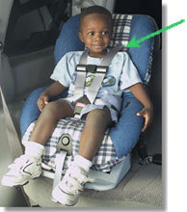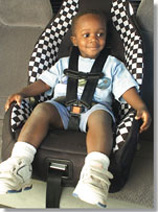The Best Seat for Your Child: One to Four Years Old
When your toddler reaches the highest weight allowed by your rear-facing infant-only seat, you need to switch to a convertible child safety seat designed to be used forward-facing. The American Academy of Pediatrics (AAP) recommends that babies should remain rear-facing until they are two (2) years of age or until they reach the highest weight or height allowed by their car safety seat’s manufacturer. (Check your car seat instruction manual or seat label for your seat's weight and height limits for rear-facing use.)
Convertible seats, forward-facing
Combination seats, forward-facing only
Convertible seats, forward-facing - May use facing forward for children over one year old and 22 pounds or more, although rear facing is the safest way to ride.
- Use until child outgrows it (when the top of the ears reach top of the seat, when shoulders are above the top slots, or when child reaches the upper weight/height limit), then move to a booster seat.
Three types of convertible seats- Five-point harness. Contains two shoulder straps, two hip straps and one crotch strap. Many safety experts prefer this system because the straps can be adjusted to fit snugly across the child’s strong hip bones.
What to watch out for: Straps may twist or tangle – keep them flat for best protection. - Tray-shield. Shoulder straps attach to a wide, padded shield that swings up.
What to watch out for: Some shields may not fit over the child’s head unless the straps are adjusted each time. It may be hard to get a snug fit on the child’s hips. In some cars, the roof may be too low so the shield cannot be lifted all the way. - T-shield seat. Do not use this seat. These seats were manufactured more than ten years ago, which is too old to use.
Combination seats, forward-facing only - Forward-facing-only seats provide a full harness for upper body and head restraint.
- Not recommended for under age one and under 20 pounds.
- Use until child outgrows it (when the top of the ears reach top of the seat, when shoulders are above the top slots, or when child reaches the upper weight/height limit), then move to a booster seat.
Source: Buckle Up Kids! A Guide for Choosing the Right Child Safety Restraint and Instructions for Correct Use, Minnesota Child Passenger Safety Program
Child Car Seat Ease-of-Use Ratings: www.safercar.gov/parents/CarSeats/Car-Seat-Ratings-Ease-Of-Use.htm
|
|
|
|
|



